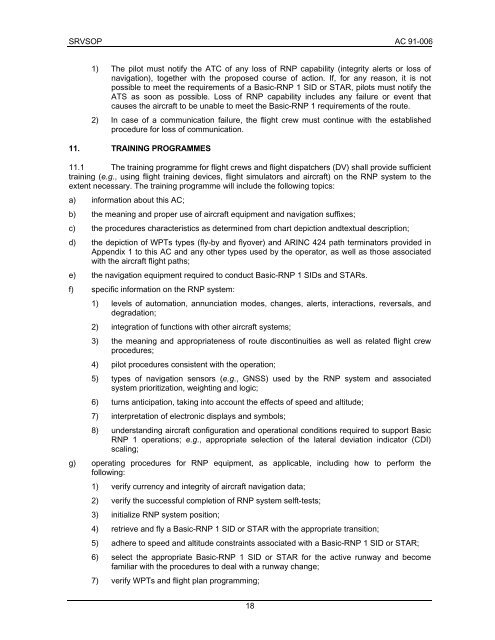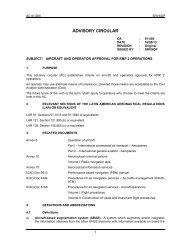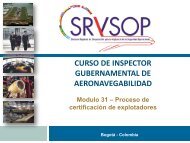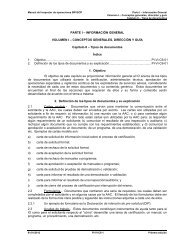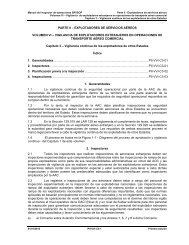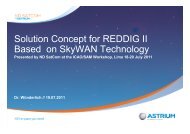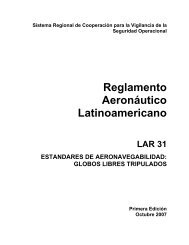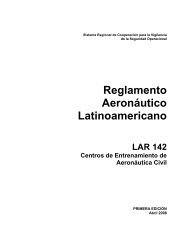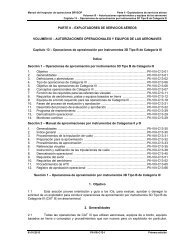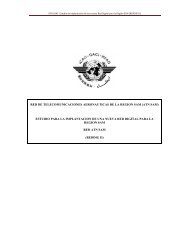ac 91-006 srvsop - ICAO
ac 91-006 srvsop - ICAO
ac 91-006 srvsop - ICAO
You also want an ePaper? Increase the reach of your titles
YUMPU automatically turns print PDFs into web optimized ePapers that Google loves.
SRVSOP AC <strong>91</strong>-<strong>006</strong><br />
1) The pilot must notify the ATC of any loss of RNP capability (integrity alerts or loss of<br />
navigation), together with the proposed course of <strong>ac</strong>tion. If, for any reason, it is not<br />
possible to meet the requirements of a Basic-RNP 1 SID or STAR, pilots must notify the<br />
ATS as soon as possible. Loss of RNP capability includes any failure or event that<br />
causes the aircraft to be unable to meet the Basic-RNP 1 requirements of the route.<br />
2) In case of a communication failure, the flight crew must continue with the established<br />
procedure for loss of communication.<br />
11. TRAINING PROGRAMMES<br />
11.1 The training programme for flight crews and flight dispatchers (DV) shall provide sufficient<br />
training (e.g., using flight training devices, flight simulators and aircraft) on the RNP system to the<br />
extent necessary. The training programme will include the following topics:<br />
a) information about this AC;<br />
b) the meaning and proper use of aircraft equipment and navigation suffixes;<br />
c) the procedures char<strong>ac</strong>teristics as determined from chart depiction andtextual description;<br />
d) the depiction of WPTs types (fly-by and flyover) and ARINC 424 path terminators provided in<br />
Appendix 1 to this AC and any other types used by the operator, as well as those associated<br />
with the aircraft flight paths;<br />
e) the navigation equipment required to conduct Basic-RNP 1 SIDs and STARs.<br />
f) specific information on the RNP system:<br />
1) levels of automation, annunciation modes, changes, alerts, inter<strong>ac</strong>tions, reversals, and<br />
degradation;<br />
2) integration of functions with other aircraft systems;<br />
3) the meaning and appropriateness of route discontinuities as well as related flight crew<br />
procedures;<br />
4) pilot procedures consistent with the operation;<br />
5) types of navigation sensors (e.g., GNSS) used by the RNP system and associated<br />
system prioritization, weighting and logic;<br />
6) turns anticipation, taking into <strong>ac</strong>count the effects of speed and altitude;<br />
7) interpretation of electronic displays and symbols;<br />
8) understanding aircraft configuration and operational conditions required to support Basic<br />
RNP 1 operations; e.g., appropriate selection of the lateral deviation indicator (CDI)<br />
scaling;<br />
g) operating procedures for RNP equipment, as applicable, including how to perform the<br />
following:<br />
1) verify currency and integrity of aircraft navigation data;<br />
2) verify the successful completion of RNP system selft-tests;<br />
3) initialize RNP system position;<br />
4) retrieve and fly a Basic-RNP 1 SID or STAR with the appropriate transition;<br />
5) adhere to speed and altitude constraints associated with a Basic-RNP 1 SID or STAR;<br />
6) select the appropriate Basic-RNP 1 SID or STAR for the <strong>ac</strong>tive runway and become<br />
familiar with the procedures to deal with a runway change;<br />
7) verify WPTs and flight plan programming;<br />
18


